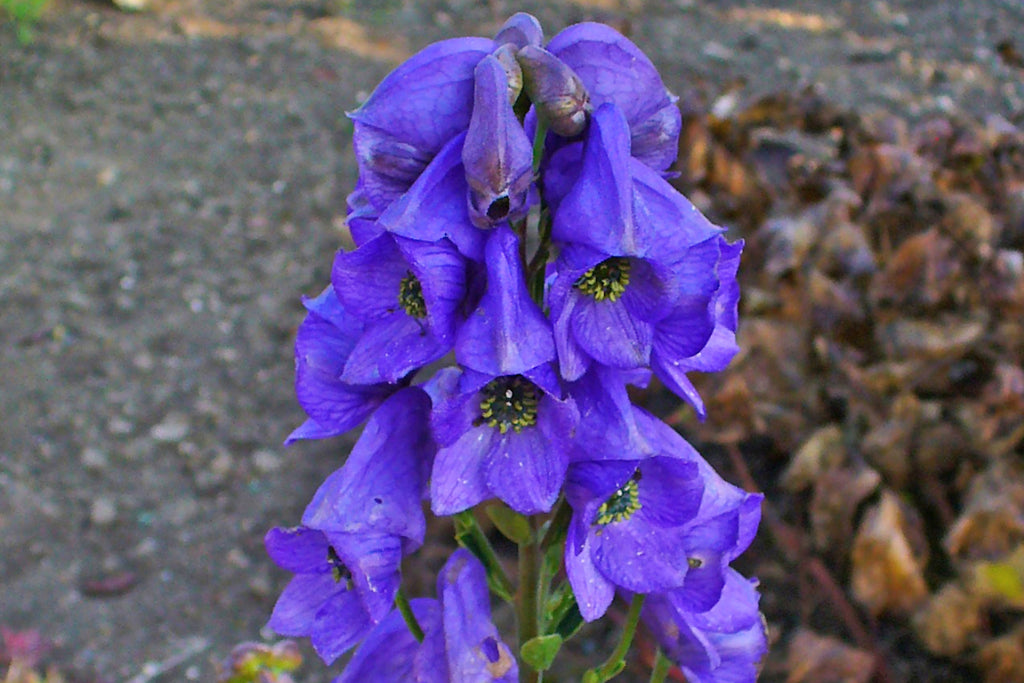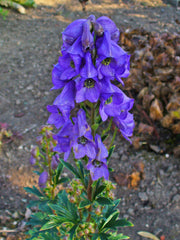




About this cultivar:
Aconitum carmichaelii (Wilsonii Group) produces lots and lots of blue flowers, and is quite tall. Carmichaelii is named after the plant hunter Captain Dugald Carmichael (1772–1827). Like most carmichaelii it will tend to flower later in the year.
Wilsonii comes from Ernest Henry "Chinese" Wilson (15 February 1876 – 15 October 1930), better known as E. H. Wilson, was a notable English plant collector and explorer who introduced a large range of about 2000 of Asian plant species to the West; some sixty bear his name.
In recognition of his service to horticulture he received many awards such as the Royal Horticultural Society's Veitch Memorial Medal in 1906 and their Victoria Medal of Honour in 1912, and the George Robert White Memorial Medal of the Massachusetts Horticultural Society. He was a fellow of the American Academy of Arts and Sciences and received an honorary M.A. degree from Harvard University and a D.Sc. degree from Trinity College.
Over 100 plants introduced by Wilson have received the First-Class Certificate or Awards of Merit of the Royal Horticultural Society of London. Sixty species and varieties of Chinese plants bear his name. In 1916–1917 Charles Sprague Sargent edited a partial list of his introductions as Plantae Wilsonianae.
The Ernest Wilson Memorial Garden is in the village of Chipping Campden, Gloucestershire. In May 2010, a blue plaque was erected at Birmingham Botanical Gardens, by the Birmingham Civic Society, marking Wilson's time there.
For the 2015 Tatton Park Flower Show the gardening staff at Tatton Park, Cheshire created the China 'Mother of Gardens' exhibit. Many of Wilson's species were used in a design based around a traditional Chinese courtyard.
- Position: Full sun, partial shade (better in partial shade)
- Soil: Almost any soil (that is not too dry) - grows well in Ballyrobert!
-
Flowers: July, August, September, October
- Other features: Royal Horticultural Society Award of Garden Merit (RHS AGM)
- Hardiness: H7 - Hardy in the severest European continental climates (< -20°C), Fully hardy - grows well in Ballyrobert!
- Habit: Columnar or Upright
- Foliage: Deciduous
- Height: 120 to 180 cm (4 - 6 ft)
- Spread: 60 to 90 cm (2 - 3 ft)
- Time to full growth: 2 to 5 years
- Plant type: Herbaceous Perennial
- Colour: Blue, green
- Goes well with: Cirsium rivulare 'Atropurpureum', Geranium 'Rozanne', most kinds of woodland plants - nice in partial shade under a tree, Monarda. Experiment with grasses!
About this genus:
Aconitum is an erect, tuberous-rooted perennial that features dense panicles of hooded flowers atop rigid, leafy stems. The upper sepal of each flower develops into a large, helmet-like structure that somewhat resembles the hood worn by medieval monks, hence the common names of monkshood and helmet flower. Leathery, dark green leaves are deeply divided into 3-5 lobes. All parts of the plant (especially the roots and seeds) are extremely poisonous - so watch out!Aconitum carmichaelii (which used to be known as Aconitum fischeri) is a species of monkshood sometimes called autumn-flowering monkshood because of its late summer to early autumn bloom. It blooms later than most other species of Aconitum. Aconitum napellus blooms mid-summer and is supposed to be native to Europe (but probably isn't since most Aconitum are found in Asia). The x cammarum cultivars of Aconitum have bi-colour flowers and also bloom in midsummer.
Most Aconitum prefer part shade. However you can try growing them in very shady areas or full sun as long as it is not too dry. They are often put near woodland type borders or perennial borders - however you can be bold and try them with some tall grasses!

